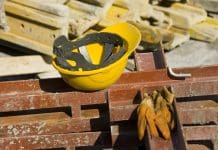Placing better information management and data sharing at the forefront of digital transformation will make construction safer – as well as smarter, says Zane Ulhaq, associate director for Atkins
When it comes to health and safety in the construction and engineering industry consultants, contractors and clients need to start thinking more collaboratively – and longer-term. There were sadly 40 construction fatalities in the UK in 2020 – more than in any other sector – and workplace injuries and work-related ill health costs the industry more than £1bn each year.
But with better information management and data use, and by defining more effective processes for quantifying risks, both public and private companies can reduce the chances of them eventuating on site and turning into incidences, which is also where costs tend to stem from, either through injury or delay.
The value of data sharing
The construction sector is a complex beast, with lengthy supply chains, multiple contractors and organisations of differing shapes and sizes. Across all these stakeholders, there’s an understanding that health and safety is of paramount importance and should always be considered. But in practice, data sharing and collaboration in this area remains limited, as does the adoption of digital technologies to facilitate it.
What this means is that the valuable knowledge people are gaining around how to be safer through design and construction practices, operation and maintenance is often staying contained within the individual, instead of spreading out across the industry. Although sharing this data would be straightforward to do, there are certain misconceptions when it comes to its commercial value that are preventing companies from disclosing it more widely. Data security and legal issues also form another barrier that many think are too difficult to be worthwhile navigating.
In reality, there is often no benefit in holding on to this data, no intellectual property requirements – nothing that would give a commercial advantage over competitors in the field. On the contrary, through sharing this data, the collective benefit is huge for people in various sections of the industry. For instance, it’s helpful for new graduates coming into the industry because it gives them a knowledge base from which they can learn and understand why things are done the way they are.
Data sharing also means specialists in one area, such as nuclear, can share their knowledge with those working in another area like highways. Whereas you might not think there is an application for your technique or way of working cross-sector, you might find that there is if that data were readily available.
Data sharing enables practitioners to pool their tacit knowledge. Organisations that have used treatments resulting in minimal or no incidents can be flagged as best practice examples to replace non-beneficial approaches. And the best thing is that data can be shared across the asset lifecycle in a way that benefits everyone. The insights can flow from design through to asset management and reused back into the design process.
How it works now
Currently, when we deliver a project design, we must document our risks. We traditionally prepare them in a spreadsheet, with categories that we create ourselves, as there is no de facto standard that everyone is mandated to follow. Once documented, the residual risks are then shared across the project stages, repurposed into different formats at each contractual handover, so that people understand which could affect who at what stage. That is then eventually handed to the client or asset owner/operator.
Typically, there isn’t a great deal of collaboration on those spreadsheets and sometimes generic, irrelevant risks are placed in documents, making it difficult for users to find the relevant information. What’s more, if anything in the brief or design changes, teams must methodically work through the static links, which always causes issues and adds a lot of extra, unnecessary steps and potential for error to the process.
How can digital technology improve the process?
An initiative, led by Atkins, that started in 2017-18 aims to standardise the process by which health and safety is managed on projects. What’s proposed is a very succinct data schema that’s in line with the standard PAS 1192-6. The system is hosted on a cloud-based tool, in which users can methodically go through their project and address their design, construction and operations risks. It connects directly into a 3D environment, so instead of a clunky spreadsheet, now you can take your risks, drop them on to your 3D model, view it and undertake design risk workshops in a manner that is far more interactive and natural.
We, as people, are familiar with the 3D because it’s how we interact with our world. 2D, on the other hand, is like learning another language. So when we revert back to 3D and operate around it, it can be helpful in recognising how things will practically be delivered in reality.
At Atkins, we’ve been trialling this process, called SafetiBase, with great success. One client employed it on a project that was used to archaic health and safety processes. Having already assessed their risks in the normal way, they used SafetiBase and found more risks they hadn’t realised were there. This new way of working helped them to realise that they can see – and therefore address – many more potential risks that could avoid an accident or even a fatality further down the line. The client is also likely to save themselves money, as they won’t have to pause work to go on site and deal with any incidents because they will already have been addressed in the design stage.
We’re currently working with the Health & Safety Executive (HSE) to find ways that we can use SafetiBase as the blueprint for a national health and safety data sharing initiative. Currently, people are hesitant to share data with the HSE because they’re worried about the potential repercussions of sharing with a regulator. But there needs to be a healthier relationship across the entire industry – and that includes sharing with the HSE because it’s the only way to take a collaborative approach to better safety. At Atkins, health and safety is embedded as standard in everything we deliver to clients.
Improving health and safety performance
Safety is the root of success. It’s not just about making sites safer – although this is obviously critically important – but if you plan heavy and look at everything in more detail, it will make project teams operationally more efficient and ultimately more profitable. Safety as a priority and continuity across projects to realise residual risks is key because consultants and contractors are only responsible for their particular part of a project.
However, collectively we all have a moral obligation to ensure that nobody is injured as a result of the work that we do. By placing health and safety at the forefront of how we approach digital transformation, we’ll find lots of other issues, from delays to overspend, will also improve.
As with digital transformation across the industry, we must create a sense of urgency and a culture that encourages change. Covid-19 has gone some way to accelerating more digital ways of working and improving processes by way of more careful on-site planning, but with better information management going forward, we can move towards far smarter and safer ways of working for everyone.
Zane Ulhaq

Associate director
Atkins
Twitter:@atkinsglobal
LinkedIn:atkins
Youtube:wsatkinsplc














